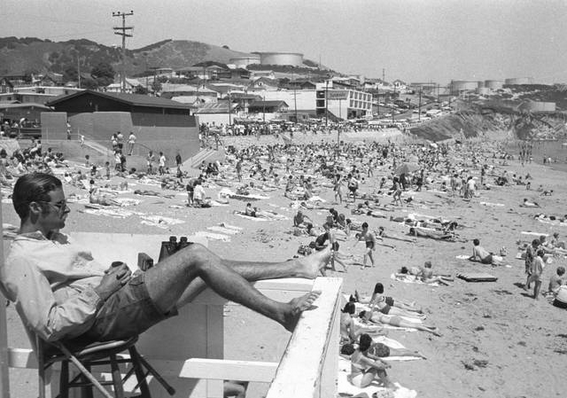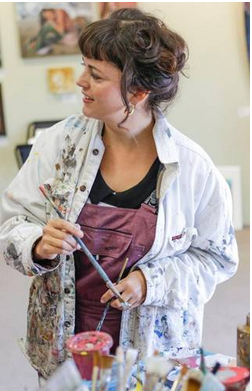Lifeguard Tower Mural Article In SLO Tribune
The real Avila Beach: New murals reveal the upscale beach town’s funky past

Get ready to meet the real Avila Beach.
“A lot of people go to Avila nowadays and they see this city by the sea that’s very upscale,” Shell Beach artist Colleen Gnos said. “I remember the old Avila. It had a lot of character. It was a very salty fishing village for over 100 years.”
She hopes to remind viewers of the once-quirky beach community’s colorful past — and flash forward to its future — with a series of murals commissioned by the Avila Beach Community Foundation. They’ll grace two 12-foot-tall lifeguard towers stationed in the sand on either side of the Avila Beach Pier, becoming the first public art of that kind in San Luis Obispo County and one of the first in the state.
The murals will be unveiled at a community celebration planned for February on the Avila Beach Promenade in front of the Custom House restaurant. The event has been delayed about a month due to stormy weather.
Avila Beach’s transformation from funky fishing village to trendy beach town came in the wake of the Unocal Corp. oil spill, discovered in 1988. During the lengthy cleanup project, the downtown area was demolished, causing the community to completely rebuild its commercial center.
According to Paula Dempsey, project specialist for the Avila Beach Community Foundation, the murals represent the nonprofit group’s first foray into public art.
“We reach out to find what’s lacking in our community, what types of things we can do to enhance the Avila Beach lifestyle experience,” said Rick Cohen, who has served as the foundation’s executive director for about nine years. “Several times the subject of public art came up.”
Together with PG&E, Chevron Corp. and the Sara Horne Art Fund, the foundation’s board came up with $21,000 for a public art project.
Arts Obispo, the San Luis Obispo County Arts Council, put out the call for San Luis Obispo County artists in August 2015. Out of the 16 artists who participated in two workshops that October, half submitted qualified applications proposing projects at select sites in Avila Beach.
“We wanted to capture the history of Avila Beach … its heritage, its culture, its industry. Colleen’s proposal captured all that,” Cohen said. “She just bowled everyone over.”
In particular, he said, the seven-member selection committee — which included representatives from the foundation, San Luis Obispo County and Port San Luis Harbor District, which owns the lifeguard towers — was impressed by Gnos’s deep roots in the community. An avid surfer known for her vibrant paintings of beachgoers, mermaids and deep sea divers, she grew up in the Sacramento area but spent summers in Avila Beach as a child.
Gnos’s maternal grandparents moved to Avila Beach in the 1930s. Antone Sylvester dove for abalone, while his wife, Dorothy, helped process the meat.
In the 1950s, the Sylvesters started a boogie board and surfboard rental stand under Avila Beach pier and a tugboat service that guided oil tankers into coastal ports. (Their fleet included the tugboat Alma, which, in 1941, helped rescue survivors from the Union Oil tanker Montebello when it was struck by a Japanese torpedo and sunk; the Kesley family donated the vessel to the Central Coast Maritime Museum Association in 1995.)
Gnos’s family — and her first-hand familiarity with Avila Beach, where she had a studio for about seven years —served as starting points as she dove into the public art project.
Gnos did two months of historical research with help from the Central Coast Maritime Museum Association, the History Center of San Luis Obispo County and the Boeker St. Trading Co. in Shell Beach.
She paged through scrapbooks, pored over old photographs and interviewed about 20 people. One of her most reliable sources was Terry J. San Filippo, who wrote the 2013 book “Images of America: Avila Beach,” with her son, Point San Luis Lighthouse docent Jack San Filippo, and Avila Beach Community Services District board president Pete Kelley.
Gnos even turned to social media for inspiration. Through Facebook, she asked people to share their memories of Avila Beach, their favorite things about the now-trendy beach town and what they’d like to see the community become.
Many of those memories resonated with her own — snacking on saltwater taffy, bumming cigarettes from bikers at the Lighthouse Bar, feeding French fries to Buster Blue, the macaw at the Old Custom House. (The parrot, she recalled, had a habit of pooping on people.) She also remembered the wave of excitement that swept across the beach whenever a gorgeous sunbather strode by in a bikini or board shorts.
“There was just so much rich history to capture,” Gnos said.
While murals on one lifeguard tower seek to recreate Avila Beach’s past, paintings on the other tower celebrate its present and look forward to its future “as I want to see it,” Gnos said.
Since the artist anticipates eco-tourism becoming a big driver of the community’s economy, she chose to portray “the natural beauty that Avila has to offer.” She painted an ocean scene complete with whales, dolphins and an underwater kelp forest populated by starfish, sea urchins and other denizens of the deep. (“I had to sneak a mermaid in there,” she said.)
Gnos also included some human inhabitants: junior lifeguards. Her sons, Bodhi and Luke, participate in the Avila Beach Junior Lifeguards Program.
In addition to her kids, Gnos’s parents have cameos in the murals, as do several other family members and friends. The artist and her husband, Che Miller, appear as their “younger, skinnier and tanner” selves, she said with a chuckle.
According to Gnos, who painted the murals with the help of community members, there are 13 lightweight, water-resistant Dibond panels per fiberglass-faced lifeguard tower — 26 in all. Each will be coated in a special sealant to protect it from the elements, and graffiti.
Gnos hopes to the murals will encourage conversations about Avila Beach. She’d like to link them one day to an app that could teach users about the area’s history.
“I really want to create that connection to the past. I don’t want it to be lost,” Gnos said.
Cohen, who has lived in Avila Beach since 1995, agreed.
“What’s happening with Avila is all the old charm is gone. A lot of the history and heritage has gone with it,” he said, adding that Gnos’ murals “will help us hopefully retain that history in a real visual form.”
Cohen also hopes the lifeguard tower murals will generate enough enthusiasm that Avila Beach will want to expand its public art footprint.
“My hope is (that) we can turn this into a campaign to raise more money for future projects,” he said, further enriching an ever-changing community.
Sarah Linn: 805-781-7907, @shelikestowatch
Community celebration
Members of the public are invited to celebrate the completion of Colleen Gnos’ lifeguard tower murals and learn more about the public art project at a celebration planned for February in front of the Custom House, 404 Front St. in Avila Beach. The event is being presented by the Avila Beach Community Foundation and Arts Obispo, the San Luis Obispo County Arts Council.
Call 805-544-9251 or visit www.facebook.com/AvilaBeachCommunityFoundation or www.artsobispo.org for updates.
